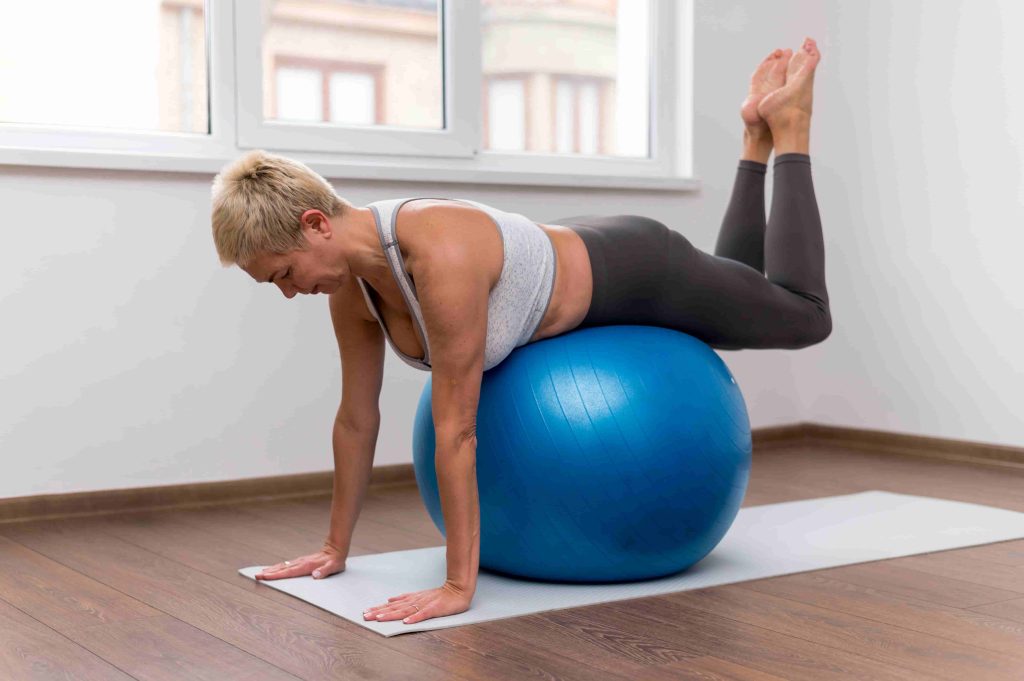9 de September de 2025
Exercise Ball Shoulder Exercises: Exercise Guide, Tips and Benefits
Exercise ball shoulder exercises combine stability and mobility training to develop stronger, more functional shoulders. Using an unstable surface like a Swiss ball adds a proprioceptive challenge, activating deep stabilizers and improving posture. In this guide, we explore the most effective ball-based shoulder movements, how to perform them correctly, and how to include them in your Strength and Conditioning (S&C) programs.
What Are Exercise Ball Shoulder Exercises?
These are shoulder-focused movements that use an exercise ball (Swiss ball) as a platform for balance, posture correction, and full-range activation. The instability of the ball requires greater neuromuscular coordination and reinforces proper alignment, especially in overhead and postural muscles.
Examples include:
- Prone shoulder raises
- Wall circles or presses using the ball
- Seated overhead presses
- Isometric holds while maintaining posture on the ball
These exercises are ideal for rehab, injury prevention, and warm-ups in strength-based programs.

How to Do Exercise Ball Shoulder Exercises Properly
Here’s how to perform a basic prone shoulder raise on the ball:
- Lie prone with your stomach and chest resting on the exercise ball.
- Place your feet against a wall or anchor for support.
- Keep your arms hanging down, thumbs pointing up.
- Slowly raise your arms to shoulder height (T or Y shape).
- Hold for 1–2 seconds and lower slowly.
Tips:
- Keep your neck in line with your spine.
- Move slowly to maintain control.
- Don’t shrug the shoulders — keep them depressed.
Variations can include internal/external rotations, wall circles, or alternating presses.
Muscles Worked by Exercise Ball Shoulder Exercises
- Deltoids (Anterior, Medial, Posterior) – For shoulder mobility and strength.
- Rotator Cuff (Supraspinatus, Infraspinatus, Teres Minor, Subscapularis) – Critical for shoulder stability and joint integrity.
- Scapular Stabilizers (Serratus Anterior, Rhomboids, Trapezius) – Support scapular control during movement.
- Core Muscles (Transverse Abdominis, Obliques) – Engage to maintain balance and posture on the ball.
These muscles work together during ball-based movements to reinforce joint integrity, overhead stability, and improved movement control.
Benefits of Exercise Ball Shoulder Exercises
- Improved Shoulder Stability: Challenges stabilizer muscles more than fixed-surface training.
- Enhanced Posture and Alignment: Encourages proper spinal and scapular alignment.
- Joint-Friendly Movement: Reduced impact makes them ideal for warm-ups and rehab.
- Proprioceptive Gains: Stimulates body awareness and motor control.
- Versatile for All Levels: Can be scaled for beginners or athletes with shoulder issues.
- Core Engagement: Core must activate throughout to maintain posture, enhancing functional transfer.
Including these exercises in S&C training builds resilience and prepares the shoulder for more demanding lifts or sport actions.
Explore how to implement these movements into a full athletic plan in our Strength and Conditioning guide.
Common Mistakes to Avoid
- Using Too Much Weight: Prioritize control and range of motion over resistance.
- Arching the Back: Compensating with lumbar extension can lead to strain. Maintain a braced core.
- Poor Ball Setup: If the ball is too large or too soft, it compromises posture and effectiveness.
- Fast, Jerky Movements: Smooth, slow reps are more effective for stabilization.
- Shrugging Shoulders: Indicates upper trap dominance — depress shoulders and engage scapular muscles.
Addressing these issues ensures better technique, safety, and long-term shoulder development.
Variations of Exercise Ball Shoulder Exercises
- Wall Ball Circles: Standing with the ball pressed against a wall, use one hand to draw circles — great for rotator cuff control.
- Seated Overhead Press: Perform dumbbell presses while sitting on a ball to activate core and shoulder stabilizers.
- Prone I-T-Y Raises: On the ball, raise arms into I, T, and Y positions to develop different angles of shoulder strength.
- Incline Shoulder External Rotation: Lying face-down on the ball with elbows bent, rotate externally to target rotator cuff.
- Isometric Holds: Hold arms at 90° for time to build endurance and stabilization.
These variations allow tailored progression based on athlete needs — from early rehab to athletic readiness.

How to Include Exercise Ball Shoulder Exercises in Your S&C Workout
Warm-Up / Prehab:
- 1–2 sets of 10–15 reps focusing on range of motion and control
Rehab / Scapular Stabilization:
- 2–3 sets of 15+ reps with low load and strict form
Posture Correction Training:
- Combine with thoracic extension or band pull-aparts
Integrated Circuits:
- Use as part of upper-body movement prep or accessory work in pressing days
For additional support on managing upper-body fatigue and ensuring shoulder recovery, check our fatigue guide.
FAQs About Exercise Ball Shoulder Exercises
What is the best exercise for shoulder pain?
Gentle external rotations, prone I-Y-T raises, and wall ball circles are often effective for alleviating shoulder pain, especially when performed slowly and under control.
What is the most effective shoulder exercise?
There’s no one-size-fits-all, but exercises that engage both mobility and stability — like face pulls, overhead presses, and external rotations — are foundational for performance and health.
How do you release super tight shoulders?
Incorporate mobility drills like wall slides, foam rolling, and stretches for the pecs and lats. Adding light dynamic work on the ball can improve tissue hydration and joint range.
What is the shoulder ball muscle called?
You’re likely referring to the deltoid, which forms the rounded contour of the shoulder and is crucial for raising the arm.
What muscles do the exercise ball work?
When used for shoulder exercises, the ball targets deltoids, rotator cuff, scapular stabilizers, and the core. Its instability also activates balance-related muscles across the body.
Do ball slams work the shoulders?
Yes. While primarily a power movement targeting the core and lats, ball slams also engage the shoulders dynamically, particularly the deltoids and scapular stabilizers.
